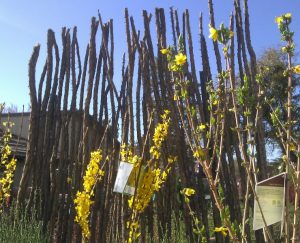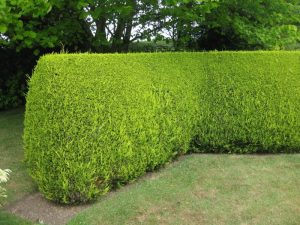Spring weather has arrived in all its mountain glory and gardeners are back outdoors. Privacy, wind breaks and hedgerows are not top-of-mind when inside waiting for the next snow storm to pass. Now that we can enjoy the patios and vistas from the deck a little privacy is important.
 All the rage has been the new six foot ocotillo fencing with its Southwestern flair, but even this all natural screen pails in comparison to a living screen. An unfortunate mistake so many homeowners make is planting a hedge that becomes massive within several years and overgrowing its space, obscuring walkways and the front of your house. Screens taller than head high can obliterate vistas and obscure sunsets. This weeks column is dedicated to those plants that are easily maintained at head height with a little manicuring. Here is my list of the top seven performs that make great scenes in local landscapes.
All the rage has been the new six foot ocotillo fencing with its Southwestern flair, but even this all natural screen pails in comparison to a living screen. An unfortunate mistake so many homeowners make is planting a hedge that becomes massive within several years and overgrowing its space, obscuring walkways and the front of your house. Screens taller than head high can obliterate vistas and obscure sunsets. This weeks column is dedicated to those plants that are easily maintained at head height with a little manicuring. Here is my list of the top seven performs that make great scenes in local landscapes.
Red Tipped Photinia is the most common plant used as a tall hedge. More maintenance is required for this aggressive 12 foot evergreen. The new growth of spring emerges red then matures to a waxy green leaf. A ladder may be required to prune this hedge if left to itself very long and too large for most properties.
Glossy Privet is be a better choice with the same look. Growing to only head high the deep green leaves form a thick hedge that ultimately reaches human height. The waxy leaves hold moisture within the plants structure creating a low water, low maintenance hedge with less bug problems that its red tipped counterpart.
Gilted Edge Silver Berry is a new hedge plant with a native twist that rivals manzanita and growing equally tall. Bright gold edges highlight every blue leaf for a truly striking hedge plant. Plant at four foot intervals and you have a head high privacy screen so thick and bright no one would dare enter. Investment property owners use this plant because it classes up a properties value yet hardy enough to keep up with a landscapes deadliest tenant.
Mint Julep Juniper is another super hardy plant your grandfather used as a hedge, but with much better color. Of course, northern Arizona is famous for our juniper forest so a juniper hedge fits and equally hardy. The signature sea foam green foliage grows quickly to head high needing little help and even less water. Forms a very thick hedge that requires infrequent hedge trimming to keep it perfectly manicured.
Victory Pyracanthia is another old fashioned plant perfectly suited to an eight foot hedge row. White flowers in spring form orange berries the birds dearly love. Thick glossy green leaves are small, surprisingly hardy and the fastest growing of the tall hedge plants. This plant has all the seasons covered for an interesting landscape. Long thorns prevent a visitors escape through this hedge, but equally safe at keeping the unwanted out.
 Golden Euonymous is the most popular of the hedge plants. Bright gold foliage appears festive and fun for year round class. An ideal hedge, it can be sheared or left to grow into a natural form dense enough to make a good visual and sound barrier. As tough as they come. Look to the Silver King Euonymus for the same design element only in a silver cream color that is equally striking. Feel free to mix and match the two for long hedge rows.
Golden Euonymous is the most popular of the hedge plants. Bright gold foliage appears festive and fun for year round class. An ideal hedge, it can be sheared or left to grow into a natural form dense enough to make a good visual and sound barrier. As tough as they come. Look to the Silver King Euonymus for the same design element only in a silver cream color that is equally striking. Feel free to mix and match the two for long hedge rows.
Oregon Grape Holly is a natural alternative. Several varieties grow wild in the mountains of Arizona. Grows quickly to six feet with minimal care. Once up to size this hedge could be cut off from all care except very infrequent water during the heat of summer. Fun gold flowers that cover this plant in early spring followed by a grape like berry; the birds will love this hedge. The leaves resemble English holly, but well adapted to our wind and bright sun. Makes an excellent hedge along driveway entrances and property lines.
Spacing is critical for a fast filling hedge. Use the plants ultimate height as the spacing recommendations for a thick hedge. If the plant tag says your plant will grow 5-7 feet tall use the small of the two numbers. Our arid Arizona climate seems to dwarf plants, or at least force them to grow on the small size of natural.
Plant of the Week is the Butterfly Lavender. Purple flowers flutter and wave above this  herbal delight. The fragrant silver foliage forms an evergreen mound. Perfect for gardeners that travel often, have dogs or abusive javalina, but want easy to care for flowers. Surround this variety with heat, sun, rocks and abuse for an even happier lavender that keeps on blooming is shades of purple. Rabbit proof and in glorious bloom right now. Enough to bring a smile on the face of any spring gardeners:)
herbal delight. The fragrant silver foliage forms an evergreen mound. Perfect for gardeners that travel often, have dogs or abusive javalina, but want easy to care for flowers. Surround this variety with heat, sun, rocks and abuse for an even happier lavender that keeps on blooming is shades of purple. Rabbit proof and in glorious bloom right now. Enough to bring a smile on the face of any spring gardeners:)
Garden Class – It’s almost time to turn the irrigation back on in the landscape. On March 30 at 9:30 I have Dan Croskey from Ewing Irrigation sharing his expertise on setting clocks, drip systems and proper local water schedules. Join me for this technical, but fun filled class.
Until next week, I’ll see you at the garden center.


A FRIEND FORWARDED THIS TO ME; WOULD LIKE TO GET IT. THANKS!
I planted Leyland Cypress with the hopes of cutting them into a hedge. I told my Gardner to trim a small amount off the bottom. He trimmed 4 feet. Do you thing I will ever get any growth at the bottom?